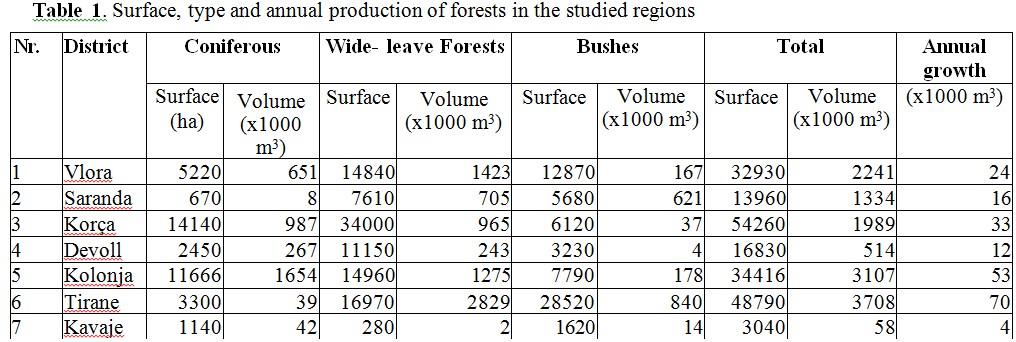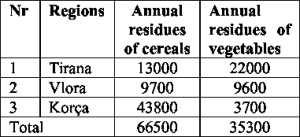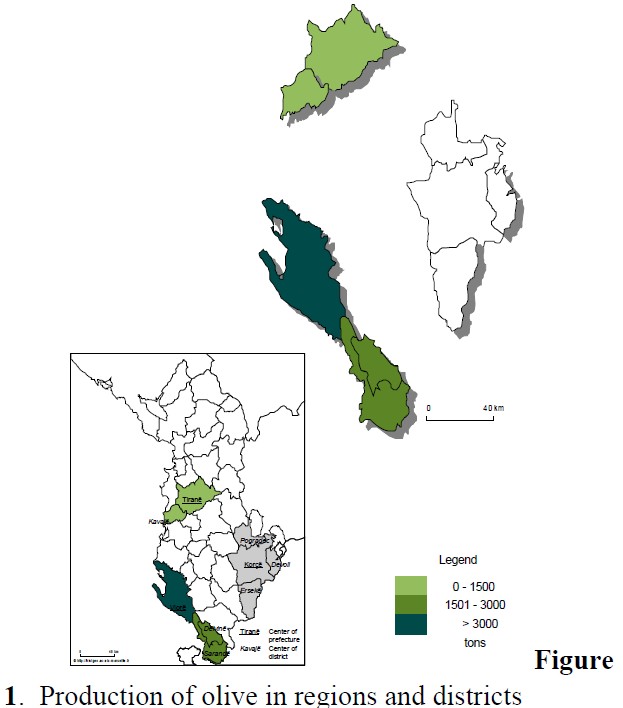THE POTENTIAL FOR BIOMASS ENERGY IN THREE ALBANIAN REGIONS
Biomass combustion is among the oldest and the most mature technique for conversion of biomass to energy, but still a great challenge lies ahead in developing new, more efficient and environmentally sustainable -systems. In light of the European Action and the National Strategy in the energy sector, Albania has enacted a friendly policy regarding renewable energy sources, including biomass. Execution of such projects is delegated to both regional and local authorities for various technical, economic and socio-environmental considerations as well as for an integrated approach to the land use planning. This paper identifies the main sources of biomass energy in three different regions of Albania i.e. Korça, Tirana and Vlora. It shows the weight of each possibility on the total potential for energy production by biomass as well as the type and distribution of each biomass. The manner how the potential offered by forestry, agriculture and agro-industry would be utilized will, apart from availability of appropriate technology, also depend on the ability of economic operators to organize themselves efficiently while respecting environmental sustainability.
Introduction
Utilization of agricultural residues is becoming an important issue in the sustainability of certain agricultural industries and in satisfying the social and environmental expectations as well as governmental regulations [1]. Agricultural residues and crops are important renewable resources that can partly replace nonrenewable sources of energy, and perhaps, can lead to the reverse of continued growth of fossil fuel consumption [2, 3]. Indeed, in the countries where the arable land ratio to population is very low, agriculture can play a complementary role since its main function is supply food sources which are indispensable to an ever growing population. This is the topic of an increasing worldwide scientific debate involving the main international organizations who express grave concern and dissent over the designation of agricultural products for energy purposes [4]. The World Energy Outlook 2006 (www.IEA.org) specifies that the world will have to face two energy-related threats: the first one being the lack of adequate and secure supplies of energy at affordable prices, and the second of environmental harm caused by consuming too much of it. Hence, it is clear that sustainable and efficient biomass production must not proceed on valuable arable land but should primarily focus on the so far neglected and abandoned plots. This means that solutions have to be proposed for lands that have been neglected and/or abandoned, e.g. because they may be degraded, polluted or non-exploited, relatively poor soils [5]. Similarly, the EREC [6] suggests that adopting the targets for bio energy will be the basis for the continuation of a sustainable EU energy policy, as well as a precondition for establishing a sustainable, competitive and secure energy mix for the future.
The main types of useable biomass material to produce electric and/or thermal energy include residue from agricultural activity (cereal chaff, branches from trees, seeds, berries, vine shoots, etc.), wood obtained after tending and maintenance of woods, agro-industrial residues (exhausted olive residue, peel, shells, stones, chaff and husks, etc.) destined for energy and/or fuel production, and lastly, industrial and civil waste, animal waste and the organic fraction of solid urban waste. In these cases biomass is obtained at the same time as the main product, but its direct use for energy purposes often presents real difficulties, such as the possibility of competitive use, wide dispersion throughout the territory and the lack of economic and organizational conditions for collection, storage and transformation.
The biomass derivate form agricultural activities is calculated using the harvest index (HI) which is defined as the ratio between economic yield and total biomass. A number of sources and publications exists dealing with these aspects, but data vary significantly. These calculations are concentrated mainly in Residue-to-Product Ratio [7, 8, 9], crop outputs, and the ratio of grain production to stalk mass [2], the proportion of product to residue or “waste factor” [10]
and the residue-yield ratio (t ha-1) [11]. The amounts of annually generated agricultural residues are normally calculated based on the annual average area of hectares harvested, yield values per hectare, and estimated residue generation factors [12, 13].
The Albanian Energy Strategy supports the development of small-scale energy facilities, especially those based on residues from the wood processing industries and agricultural activities, which are considered an important alternative energy source [8]. The use of electric energy for warm water and the heating of public buildings is a heavy burden to the Albanian energy sector, whose main source is based on hydro and oil. Agricultural residues in Albania could, to a certain extent, substitute the use of high-price energy, especially at the local level where they have insignificant market value and very low transport cost, and by utilizing simple and low cost equipment (e.g. boilers). Residues of cereal straw and of olives from the olive oil production industry are substantial in Albania. Furthermore, the planting of new olive trees (about 10 million new olive trees planted in the last five years) would further encourage the use of residues from this industry.
This study provides an overview of the most important trends of biomass energy production and conversion technologies in Albania, which in turn might influence the major agricultural and forest sector development policies. Furthermore, policy proposal are prepared amongst others for research and development activities, the establishment of demonstration sites, as well as for extension of educational activities in Albania. This paper instigates identification for the biomass capacities on the regions of Vlora, Tirana and Korça, which are the main regions for the production of olives and cereals on the national level, and analyzes the economic feasibility of using the wheat straw and the olive oil residues as alternative energy solution.
- Methodology
The study was structured in two main stages: Resource Evaluation and Availability, and Technology Analysis for the optimal biomass energy valorization. The methodology has been applied to a representative geographical area of Mediterranean climate and with typical biomass resources for this climate, where a considerable part of the total area is assigned to agricultural, industrial and urban use. In order to evaluate the different types, quantities, and uses of biomasses, three prefectures were studied, namely Vlora Tirana and Korca. The following districts or townships were selected in those three prefectures: Vlora, Saranda, Tirana, Korca, Devoll, and Kolonja. Thus, in Vlora prefecture have been selected two districts out of three, in Tirana one of two, while in Korca have been selected all the three districts. The selection was based of their special features in annual production plan of biomass. In the prefecture of Vlora and Tirana, the products from olives were analyzed in detail, as that was the most important energetic source of biomass. The products of agricultural crops and fruit-culture were analyzed in Korca, while in Devoll the focus was on the production of biomass from agricultural crops and in Kolonja the production of biomass from forest and forest industry.
This methodology included the collection of general information regarding to cartographic (mapping of agricultural areas, type of crops, forest areas, industrial activities, etc.) and statistical data for each municipality (population, types of dwelling, services, industries, etc.), biomass characterization, dispersion and seasonality analysis of the resources.
During the resource evaluation phase, agricultural and forestry data was collected and organized into a database structured in municipalities. Information gathered included:
- Data concerning biomass resources including crop types and biomass residues,
- Topography of the soil and possible management of the potential biomass residues.
- Information concerning agricultural as well as wood, agro alimentary and other industries activities.
- Cartographic data from the area of study (municipalities, area distribution: urban, industrial, agricultural, forests).
- Data related to accessibility and road transport network.
- Data on population, economy and socio-cultural environment.
- Results and Discussion 3.1 Forestry biomass
Biomass can be classified into eight categories: natural forest woodlands, forest plantations, agroindustrial plantations, tree outside forests and woodlands, agricultural crops, crop residues, proceed residues and animal wastes [14, 15]. This work focused mainly on the assessment of residual biomasses such as forestry, wood industry residues, agricultural residues, agro industry residues on the first phase and on the most efficiency identified biomass in the second phase. In the districts taken in consideration, in the first place for the wooden surfaces is Korca with about 54,000 ha of forests and bushes; in the second is Tirana with 48,000 ha of forests and then Kolonja with 35,000 ha of forests (Table 1). The districts of Vlora, Saranda and Kavaja have limited forestry areas. On the other side, it should be emphasized that the important parts of those surfaces are strictly protected zones or National Parks; they are 34%, 20% and 35% for Tirana, Vlora and Korça regions, respectively.
3.2 Woody residues evaluation
In Albania there is a net of industries of wood sawing and wood elaboration for domestic furniture. Although an important part of wood matter comes from the import, competing with the quality and prices, there is a considerable consume of the country wood. In Tirana, differently from the two other districts, the wood manufactures generally use imported wood matter, but the wood remnants are used as biomass in industry or in other simple thermal processes. The quantities of elaborated wood vary from 18,000 m3 year-1 in the district of Vlora to 54,000 m3 year-1 in the district of Tirana (Table 2). Their annual remnants (in forms of saw-dust, unsuitable wood or chips of wood) in tons of equivalent diesel are: 1000-2600 and 8700 tons/year for Vlora and Tirana respectively. Compared to the energetic surplus obtained from the annual growth of forest biomass these quantities are 4, 3.7, and 12 % of it in the districts of Vlora, Korça and Tirana respectively.
Table 2. Annual wood processing manufactured and their residues
The positive thing about this kind of biomass is that the cost is very low and consists on the packing, conditioning and transport. On the other hand, the fact that they are produced in the urban areas with high density of population makes its use as energetic matter more attractive because those have often energetic sources deficits.
Another important biomass source derived from the orchards. The potentially usable biomass is smaller than the total biomass, because a part of remnants of prunes, are burned from the farmers for different purposes as cooking and/or warming. According the data provided form INSTAT [16], it turns out that the potential biomass in Albania, calculated for the main agricultural cultures is about 457 000 tons for year, while the biomass of zoological origin is about 10.5 million tons (2005). It is clear that not all the quantity of biomass can be used. The biomass of fruit trees is more important in the district of Korca with about 20 000 tons year-1, followed from Tirana and Vlora with 17 000 tons year-1 and then Saranda about 7000 tons year-1. Kolonja produces 3000 tons year-1 which is very low compared to the forest biomass produced in this district. The thermal energy produced by these biomasses comes in the same rank. The fruit cultures that dominate this biomass depend on the climate areas; in Korca the quantities of biomass are totally dedicated to the fruit trees and vineyards. These occupy greater areas in Korca than in the other districts of the study. In Vlora and Saranda the biomasses originate mainly from olive trees, while in Tirana the sources of biomass are the fruit and olive trees.
3.3 Herbaceous residues
The quantities of agricultural harvest residues included as herbaceous are presented at Table 3. They are separated in tow category: (i) the residues coming from cereals and (ii) from other plant where mostly vegetables residues are. Korca region have greater than other; they are higher than Tirana (48000 v.s 3500 ton year-1) and much higher than Vlora (4800 v.s 19000 ton year-1). The residues at Tirana are dominated from vegetables while at Korça form cereals. Compared with wood residues the herbaceous residues are several times larger in quantity.
Table 3. The estimated herbaceous residues (in tons)
They can be locally used for the warming of water or public premises, but do not constitute an important source for use in energetic centrals of whatever dimension because: (i) the space in which these remnants are produced is very wide and it is not near to urban centers, excluding the field of Korca where can be used in the cities of Maliq and Korca; (ii) in the mountainous and hilly areas (Tirana, Devoll, Sarande, and Vlore), the greatest part of reed is used for the needs of farmers families (food source for the equines) and (iii) even if remains a considerable quantity of this biomass in the mentioned districts, the transport would increase the costs in an unaffordable way for its energetic utilization.
3.4 Oil olive processing industry residues
In tow regions (Tirana and Vlora) an important source of energy was identified; the residues after the oil olive production (Table 4). The olive remnants which are present in the western part of the country are energetic sources that are not used or used too title. Furthermore they have become a problem for the elaborators who continuously need to eliminate them. Currently their use consists on the energetic supply for the elaboration manufactures. This is important because the olive residues have an energy of about 17 000 KJ kg-1 which is a considerable energetic value. In these conditions, the olive residues represent an important energetic alternative for the supply of the consumers, private (restaurants etc) or public (schools, kindergartens etc), in either their unelaborated form or elaborated one (with high density units). In our area of study this energetic possibility belongs only to the western districts (Tirana, Vlora, and Saranda), which are the most important producers of olive in the country.
Table 4 Quantities of olive production and residues of olive in our study area
The main country producer of olive is Vlora, because of its localization and climate which optimize the production of olive. Although the amount of waste from olive oil production compared to other categories of waste is less high energy value makes it more efficient to the energy production. The figure below is built taking in considering the same level of elaboration for all the administrative units inside the region that are studied. The map clearly shows that the district of Vlora is the most important producer, followed from Saranda and at the end is placed Tirana.
This level of production implies an important energetic level, which is used to little, or not used at all. The main problems that the use of this energetic source has:
- The transformation sources are small or very small and although they have an acceptable level of mechanization, are not able to elaborate more than 80 tons per year and the residues offered from one unit are low. Beside the costs of transport, there is also the cost of transaction to obtain a considerable quantity of residues in order to supply a consumer continuously.
- The production of olive in our country follows a high periodicity; e.g. during the last three years, the production reduced more than 60 % in 2007, and there was an increase in 2006 compared to 2005.
Another element that makes difficult the utilization of olive residues as an alternative energetic mean is also the lack of the tradition in the use of this source and the investments that are requested. Currently in our country there are very few units that are specialized for offering the suitable technology and the necessary services for the olive elaboration remnants [17]. The relatively low prices of other energetic sources (mainly the wood for combustion) has postponed this process, but the continuous growth of the price of electric energy, petrol, gas and its derivates as a result of the international prices growth and a low transparency of markets and national operators, has directed the attention of the consumers towards the alternative sources of energy. In these conditions, it is create the possibility for the utilization of these sources for warming or in place of wood matter. The main positive element in the use of olive residues is that these residues can be used without using extra costs, making easier their utilization.
3.5 The potential energy biomass
Converting all potential biomasses (expressed in Gwh year-1) result that the district with the highest level of energy is the Korca, while the districts with the lowest level are the districts of Kolonja and Devoll (211, 31.2 and 32.5, respectively). The other districts beside Vlora have a yearly capacity that varies from 50 to 90 Gwh year-1, while Vlora, potentially,produces about 115.8 Gwh year-1, but these figures should be relativized as these districts have different surfaces. If we elaborate the figures according to the surfaces or inhabitants, we can note that the energetic production is much more different (Table 5).
 It can be noted that differently from the total energetic level of the districts, it is the district of Kavaja that has the greatest energetic level for surface unit, while the district of Korca is placed in the middle group of districts. While the analysis of production for 1000 inhabitants shows that the district of Saranda has the greatest production together with Kolonja that had the lowest total energetic production. Another evident remark is that the district of Tirana has the lowest level of energetic production for surface unit and for inhabitants. From the ratio of energy and surface, we can note the most advantaged districts are those in which the energy from agricultural products (reed olives) predominates, while in the ratios of energy and inhabitants, the most productive districts are those that have great surfaces of forests (as a result of the low density of population). This analysis helps us to have a relative level of gross production.
It can be noted that differently from the total energetic level of the districts, it is the district of Kavaja that has the greatest energetic level for surface unit, while the district of Korca is placed in the middle group of districts. While the analysis of production for 1000 inhabitants shows that the district of Saranda has the greatest production together with Kolonja that had the lowest total energetic production. Another evident remark is that the district of Tirana has the lowest level of energetic production for surface unit and for inhabitants. From the ratio of energy and surface, we can note the most advantaged districts are those in which the energy from agricultural products (reed olives) predominates, while in the ratios of energy and inhabitants, the most productive districts are those that have great surfaces of forests (as a result of the low density of population). This analysis helps us to have a relative level of gross production.
Theoretically, the energetic sources structure according the regions and the districts is presented at Figure 2.
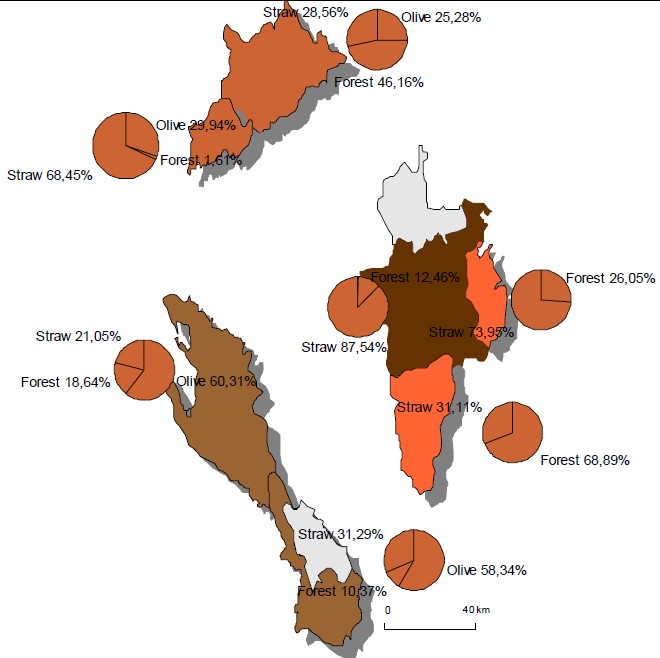
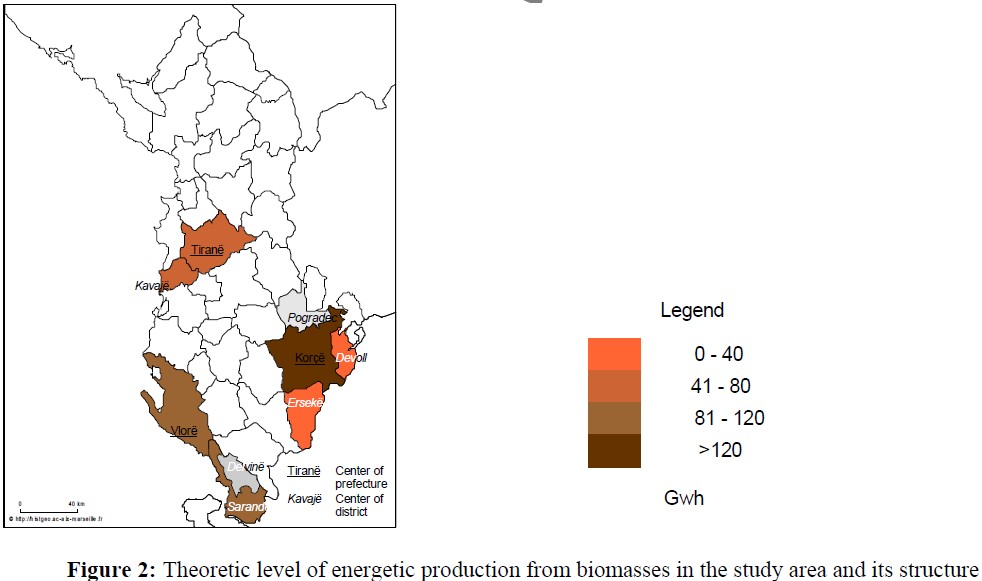
The data figured above shows that the source kind of energy generation is very different; they can classify the districts in three main groups: (i) district which energy is generated from the cereals reed (Korca, Kavaja, Devolli), (ii) districts which energy is generated from the olive residues (Saranda, Vlora) and (iii) the districts which energy is generated from remnants of wood elaboration (Tirana, Kolonja). Another interesting element is the diversity of kinds of biomass energy that exist inside the regional territory. Generally, the energy is produced from two kinds of sources, excluding Tirana where there is a more equal distribution between the three sources. This distribution firstly related to the agro-climatic features of the areas of our study. In the Table 6 it’s presented the diversity index of generation of energy. This index is the ratio between the energetic remount quantities from the adding of a source over the accumulated energetic quantity, where the energetic sources are listed from the most important to the less important. In the case of two sources the index is calculated according formula : D2 = P2 /(P1+P2) , while in the case of three products the formula is: D3 = P3 / (P1+P2+P3) .
The data elaborated indicates that the districts with the highest level of diversity are Tirana, Saranda, and Vlora, while those with the lowest are Korca, Kolonja and Devoll.
3.6 The economic efficiency of the use of alternative energetic sources
To compare the efficiency of each energetic source an economic analysis is develop. The utilization of these sources is related to the question if these are efficient and are able to complete the traditional energetic sources used in the country. For this analysis we are based on the costs of transport that these sources are related, in order to be used. Considering that all the sources that are studied (reed, olive residues, and sawdust) there are no alternative uses, than the cost of their purchase is equal to zero and the main element of the cost of their use, is the cost of transport from the site of their production (farms, saw installments or the olive elaboration manufactures). Not having references for the costs of transport of a product. The cost is calculated based on some suppositions. To calculate the level of expenses for one kilometer, is used the method of calculation proposed by Jojic in 2007 [19], for the use of means. Expressed in euro the cost per kilometer is 0.20 € km–1, while the invariable cost and variable cost are 0.17 and 0.03 € km-1, respectively. The cost values shows that the transport costs are not a problem in the use of electric energy and at any case, their use (whenever the initial and technology costs are equal to zero) is more efficient than the use of electric energy. In our analysis we have not taken in consideration the unreliability of the supply with electric energy and the costs of transactions of alternative energy, which would complete our analysis.
- Conclusions
Biomass from woods, agriculture and food industry residues such as olive oil and wine production, were used since a long time by people in Albania. Natural resource depletion as a result of human needs and higher urban pressure as well as the need for environmental protection both compel for application of efficient technologies to utilize residues as a sustainable solution to environmental preservation and alternative energy. The survey shows that albeit in small quantities, there are biomass sources for alternative energy which could efficiently be used in small-scale energy production facilities. The residues from the olive oil production industry seem a viable source of alternative energy for Saranda and Vlora regions. Due to the high energy value, combined with very low transport cost and insignificant market value offered by the olive oil production plants, the use of such residues is a feasible efficient alternative for energy production, heating of public buildings, or other needs of the population. Apart of the economic benefits, it also helps with removal of waste from inappropriate dumping practices.

